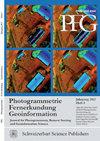棉花吸收光合有效辐射比值的两种统计方法的比较
Q Social Sciences
引用次数: 6
摘要
光合有效辐射吸收分数(FAPAR)是模拟生物量增加和农业产量的重要输入,可基于光学遥感数据计算。本研究对乌兹别克斯坦费尔干纳河谷灌溉棉花FAPAR的两种基于遥感的方法进行了测试和比较:(i)基于归一化植被指数(NDVI)的FAPAR重新标度(“百分位法”)和(ii)基于NDVI的经验回归方法。在重标度方法中,将整个研究区棉田NDVI分布的上、下百分位数与固定的FAPAR最小值(裸土)和最大值联系起来,得出FAPAR。NDVI来自于2011年全年获得的6.5 m RapidEye数据。对于回归方法,FAPAR数据是在植被季节从棉田现场收集的。百分位方法的RMSE为0.10,而回归的RMSE仅略好于0.07。因此,对于需要经验回归的田间数据,百分位数法可以作为一种快速简便的替代方法来推导棉花田的FAPAR。本文章由计算机程序翻译,如有差异,请以英文原文为准。
Comparison of two Statistical Methods for the Derivation of the Fraction of Absorbed Photosynthetic Active Radiation for Cotton
The fraction of absorbed photosynthetic active radiation (FAPAR) is an important input for modelling biomass increase and agricultural yield and can be calculated based on optical remote sensing data. In this study two remote sensing based approaches to derive the FAPAR for irrigated cotton in Fergana valley, Uzbekistan, are tested and compared: (i) FAPAR rescale from the normalized difference vegetation index (NDVI) (“percentile approach”), and (ii) an empirical regression approach based on NDVI. In the rescaling approach FAPAR was derived by relating upper and lower percentiles derived from the NDVI distribution of cotton fields from the entire study area to fixed FAPAR minima (bare soil) and maxima. NDVI was derived from multi-temporal 6.5 m RapidEye data acquired throughout 2011. For the regression approach FAPAR data was collected in situ from cotton fields during the vegetation season. The percentile approach delivered an RMSE of 0.10 whilst regression was only slightly better with an RMSE of 0.07. Hence, the percentile approach could be concluded as being a fast and easy alternative to field data demanding empirical regressions for the derivation of FAPAR on cotton fields.
求助全文
通过发布文献求助,成功后即可免费获取论文全文。
去求助
来源期刊

Photogrammetrie Fernerkundung Geoinformation
REMOTE SENSING-IMAGING SCIENCE & PHOTOGRAPHIC TECHNOLOGY
CiteScore
1.36
自引率
0.00%
发文量
0
审稿时长
>12 weeks
 求助内容:
求助内容: 应助结果提醒方式:
应助结果提醒方式:


